Can 32-year-old Anthony Davis still rank among the top ten in the league?
6:20pm, 23 October 2025Basketball
The data and historical comparisons of the past 30 years are unfavorable to AD, but there is still room for optimism
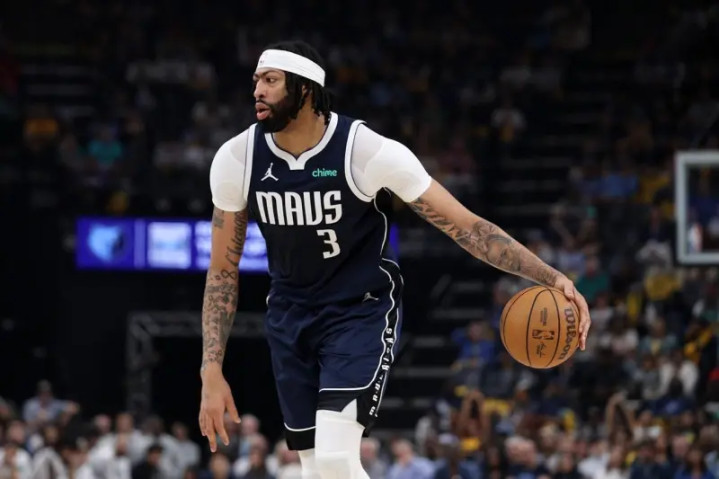
Last September, I wrote an article exploring the macro issue of how the Dallas Mavericks can remain competitive after unexpectedly reaching the Finals. In my article discussing Kyrie Irving's timeline, I analyzed in depth how we realistically expect Irving to remain at his peak for a few more years based on his age, injury history, and historical references. There were certainly reasons to be optimistic at the time.
However, the situation suddenly changed. Luka Doncic was traded and Irving suffered a major anterior cruciate ligament injury. He will miss at least most of the first half of the upcoming season. The Mavericks failed to find their way into the lottery, only to land the No. 1 pick in Cooper Flagg, acquiring one of the best rookie talents in recent memory -- making the team's long-term future far brighter than it was in April, when the bruised Mavericks fell to the Memphis Grizzlies in the playoffs and missed the playoffs.
But in terms of the short-term future of this season, the key question I want to ask is the same as the topic I asked last September: Can a 32-year-old superstar with a poor attendance record maintain his peak level for at least another year?
Only this time the protagonist is no longer Irving, but Anthony Davis.
As before, when I conducted this analysis, I have to thank my friend Jeff Stotts, founder of the injury intelligence website InStreetClothes.com, who provided valuable input and help with historical injury-related data.
1. The biggest premise: "If he stays healthy"
"If Davis can maintain consecutive healthy seasons, he will naturally be a top ten player."
"Objectively speaking, this is a top ten player, and when healthy, he is one of the top offensive and defensive players."
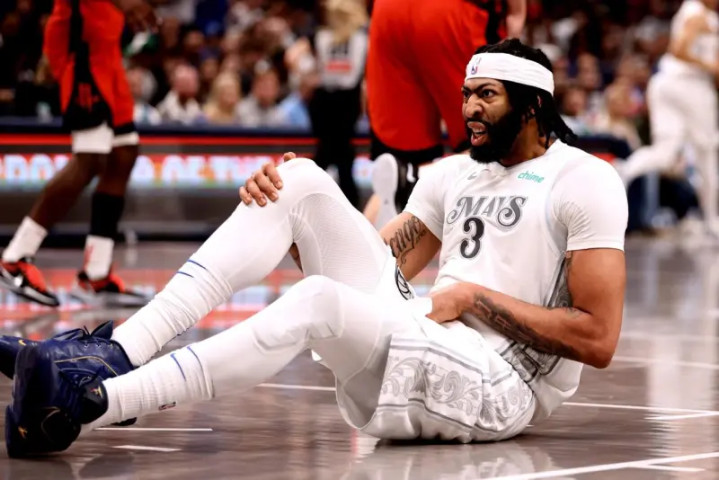
These are the two statements that impressed me most in the discussion about Anthony Davis on various Mavs-themed podcasts this summer. These views are not groundless. Just last season, Davis' performance was undisputed: averaging 24.7 points, 12.6 rebounds and 2.3 blocks per game. He ranked fourth in the Defensive Player of the Year selection, was selected to the second team and first defense, and once again became an All-Star.
Of course, the key to Davis always lies in the premise of "if/when he can stay healthy."
After that outstanding season, he continued to perform at a top-10 level and got off to a hot start for the Lakers at the beginning of the 2024-25 season. But it ended up being another season riddled with injuries: heel contusions, abdominal and adductor strains continued one after another, forcing him to miss as many as 31 games, and only played in 9 games after joining the Mavericks. AD's recent health problems are not over. There were reports this summer that he underwent surgery to repair a detached retina, which undoubtedly frightened Mavericks fans and led to his late participation in 5-on-5 training.
2. Best Team Selection: An Award for Young People
How long will it take for Davis to return to his peak? I think the real key is: Even if he stays healthy, can he still be among the top ten in the league when he enters the 32-33-year-old season (he will turn 33 next March)?
In order to explore historical precedents, I used the analysis of the best lineups (including the first to third lineups) as the starting point for research, going back to 1994, covering more than 30 years of data. After all, being selected for the All-NBA Team is an important sign that a player ranks among the top 10-15 players in the league.
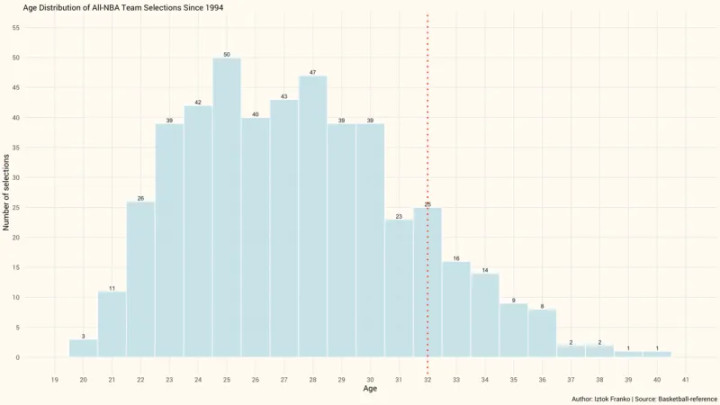
(Age distribution of players selected for the All-NBA Team since 1994)
The first conclusion drawn from the data is: the All-NBA Team selection is actually an award for young people. The average age of players selected to the All-NBA team is only 27.5 years old.
Of a total of 480 seats available over 32 years, only 78 (16%) came from players who were 32 or older at the start of the season. Since 1994, only 36 veterans have won this award, among which LeBron James (9 times), Karl Malone (6 times) and Stephen Curry (5 times) are particularly dazzling.
3. The big man’s peak comes earlier? Let's look at this elite list.
The next step in the analysis is to examine whether All-NBA selections differ by position, narrowing the study to big men who are more comparable to Davis. The results do show a difference: The age distribution curve for centers shows that they tend to peak earlier than smaller guards.
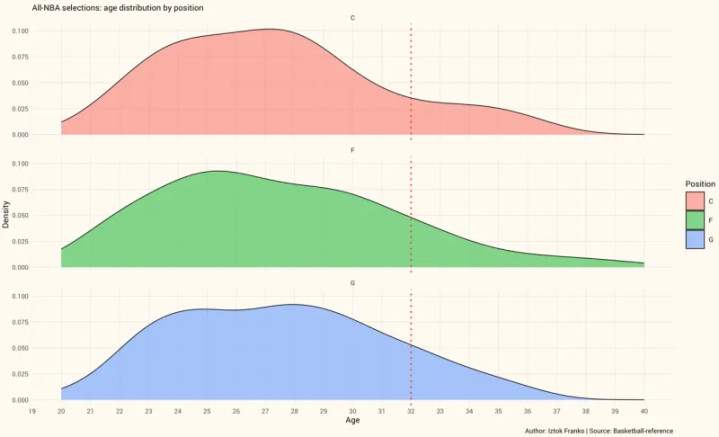
(Age distribution of different positions in the best lineup)
Now some may argue that AD is not a traditional center, and the Mavericks intend to use him as a power forward to build a new era to reduce the load and wear and tear on him when he is nearly 35 years old.
To find a historical reference for Davis (players selected to the All-NBA team after the age of 32), I narrowed the list to only centers and power forwards. I'm excluding players who bounce between front and backcourt positions like Dominique Wilkins, Dennis Rodman, Detlef Schrempf, Scottie Pippen, LeBron James, Jimmy Butler, DeMar DeRozan, Kevin Durant and Kawhi Leonard, who spend a lot of time between small forward and power forward rather than closer to the basket on both ends like a big man like Davis.
Thus, since 1994, only 11 big men have actually been selected to the All-NBA team at the age of 32 or older. If you look closely, most of these selections occurred in the 1990s and 2000s, a period dominated by physical big men before today's faster-paced, space-oriented era.
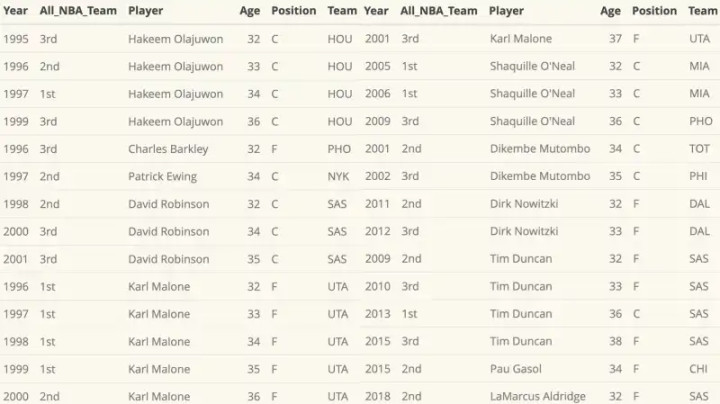
Since 2010, only four players have met the criteria: Dirk Nowitzki, Tim Duncan, Pau Gasol, and LaMarcus Aldridge—the closest we got to it, in 2018.. I think those four should be enough to provide a baseline for comparing Davis' age curve and eventual decline, but to broaden the sample, I'm also including top players on defense. So I turned to the All-Defensive lineup since 2008.
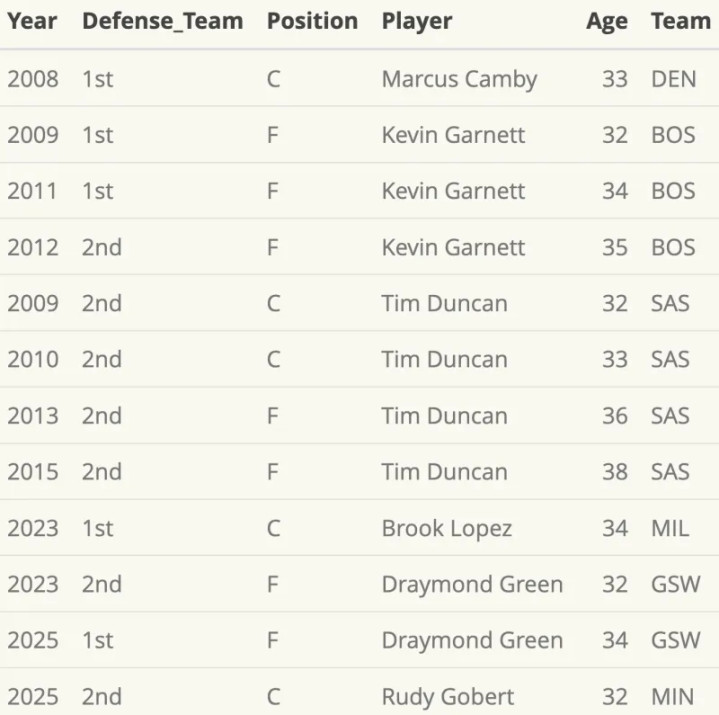
By expanding the scope to the All-Defensive Team, five more players join the list of players who are still having high-impact seasons after turning 32: Marcus Camby, Kevin Garnett, Brook Lopez, Draymond Green and Rudy Gobert.
4. Injury history of big men selected to the All-NBA or All-Defensive teams after the age of 32
When studying the players mentioned above, my initial impression: With a few exceptions, most of them have shown amazing durability early in their careers. To test this hypothesis, I carefully calculated the number of games each player missed each season, going back to 1984, the year the oldest player on the roster began his career.
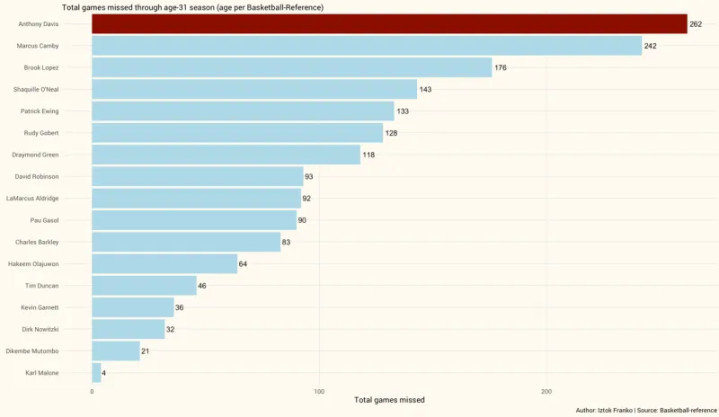
(The number of missed games before the age of 31 for big men who can still be selected for the All-NBA/Defensive Team after the age of 32)
I also calculated the percentage of missed games. After all, the age difference of players entering the league needs to be taken into account. For example, Davis entered the league at 19 years old, while Duncan was 21 years old, Camby was 22 years old, and Youyin was 23 years old.
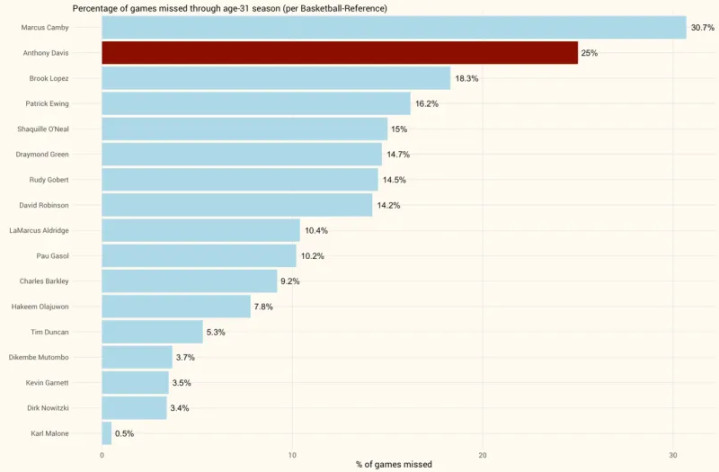
(The absence rate of big men who can still be selected for the best team/defensive team after the age of 32 before the age of 31)
Although the ranking order has changed, it will not be earth-shaking. Most players who have been selected to the All-NBA team after the age of 32, especially those who have achieved this achievement relatively recently in the modern NBA, also come from players with high attendance rates. Unfortunately, Davis tops the list of missed games.
5. Reasons for Cautious Optimism, and the Interesting Case of Marcus Camby
The numbers so far may be unsettling for Mavericks and AD fans, and the next chart, in which I expand the list to include more recent big men who have been impactful but lack the lasting primes of earlier players, probably won't do much to ease those nerves. But please be patient.
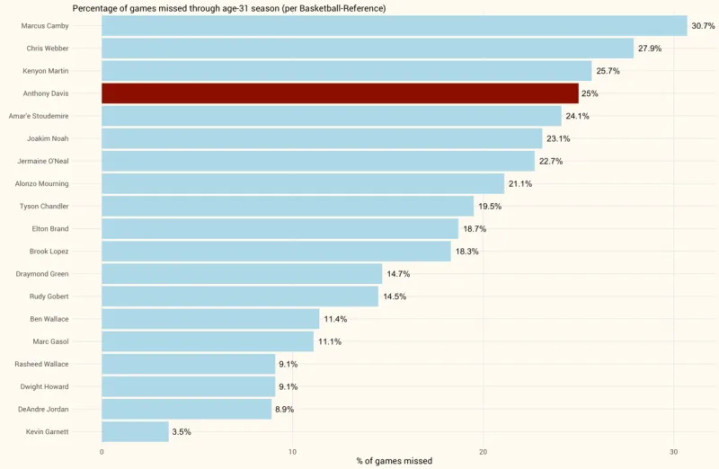
(Absence rate of more big men before the age of 31)
Davis's career absence rate is indeed at the forefront of these big men, and the data is close to players such as Amar'e Stoudemire, Kenyon Martin and Chris Webber. These players' peak years, and in some cases their entire careers, were cut short by a steady stream of injuries. But after talking with Stotts and digging into the injury database, I think there's still hope for Davis, and that's the type of injury he suffered.
Stotts recorded more injuries to Davis than any other big man in the comparisons I made, but most of them were minor injuries. Players like Chris Webber, Dwight Howard, Joakim Noah and Jermaine O'Neal have all suffered major injuries and surgeries to their back or lower body. Davis has only undergone one surgery on the above-mentioned major body parts in his career (he had surgery after injuring the patellar ligament of his left knee in 2016 and missed the Rio Olympics as a result), which is more in line with what Stotts called "a bunch of minor problems."
So I think Marcus Camby is an interesting reference point. He is one of the few players who misses a higher percentage of games before the age of 32 than Davis. Camby, like Davis, bears the label of a "glass" big man, and his career follows a similar pattern: a large number of missed games in each season, but none of them were truly catastrophic injuries. But Camby shed some of that notoriety in his early thirties. From 2005 to 2008, that is, between the ages of 31 and 33, he led the league in blocked shots for three consecutive years, thereby being selected to the first defense twice and the second team once. He reached his peak in 2007 and won the Defensive Player of the Year - he had just turned 33 years old, the same age as Davis the next spring. More importantly, in the four seasons from the age of 32 to 35, he played 70, 79, 62 and 74 games respectively, averaging more than 31 minutes per game.
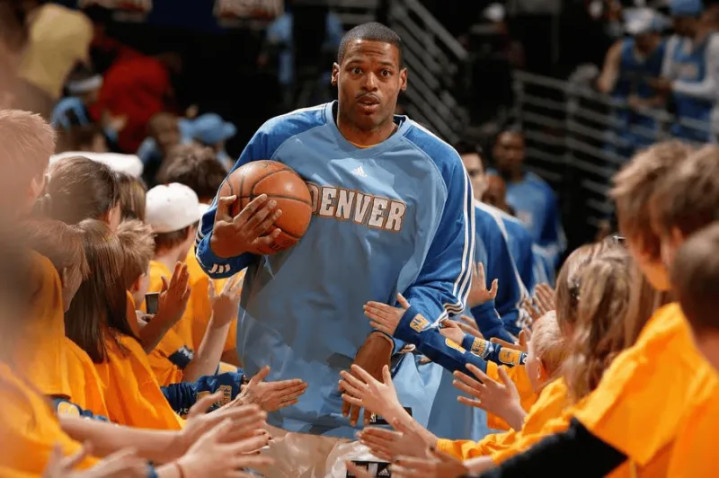
I am not predicting here that Davis will completely go back to such a path. But the point is, there is historical precedent for an athletic defensive core plagued by injuries who can rewrite the narrative later in his career. Of course, there is still a major difference between the two: when Davis entered the 32-33-year-old season, he had played three full seasons, 241 games, and nearly 11,000 minutes more than Camby in the same period.
That said, no team is better equipped to manage this attrition than the Dallas Mavericks, who now have one of the deepest frontcourts in the league. Davis will have the unparalleled luxury of playing alongside two decent centers in Derek Lively II and Daniel Gafford, something he has longed for since the 21-22 season in Los Angeles, when his frontcourt partners were 36-year-old Howard and 33-year-old DeAndre Jordan. Coupled with P.J. Washington and rookie Cooper Flagg, both of whom can serve as power forward and flexibly adjust their positions in different lineups, Jason Kidd has ample and comprehensive options in AD's load management.
The key challenge for Kidd is to resist the temptation during Irving's absence during the early part of the season and avoid overloading Davis with the heavy responsibility of scoring and main attack points. With Flagg, Klay Thompson, D'Angelo Russell, P.J. Washington, Najee Marshall and others, the Mavericks' lineup should be deep enough to share this pressure.
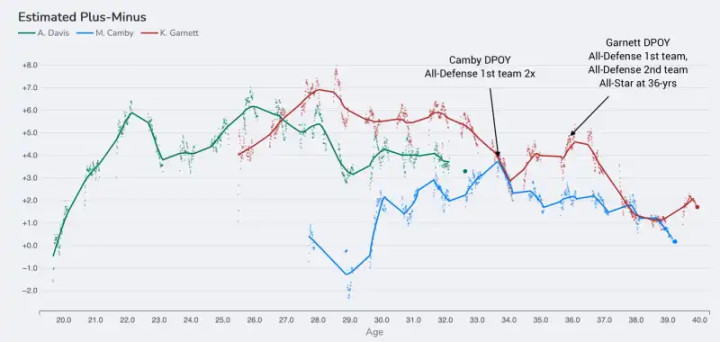
(EPM comparison line chart of Davis [green], Camby [blue] and Garnett [red])
Once Irving is expected to return to form, and Flagg has also grown into a scorer and creator with the ball, the wiser long-term path for Davis and the Mavericks may be to completely transform him into a defensive pillar instead of shouldering too much offensive burden. This is exactly the transformation that Kevin Garnett, who is nearly 35 years old, has completed in the Celtics, which is also full of talents.. Garnett, like Camby, succeeded in this positioning. He was still selected for the first defense and second team at the age of 34 and 35, and continued his influence into his nearly forties.
Perhaps that transformation will begin this season, or maybe Davis can still prove that he can still be a good offensive and defensive player and put himself back into the conversation for the top ten in the league. When the Mavericks traded for him, they knew full well that they were taking a huge gamble, and history shows that only a handful of big men remain at the top past the age of thirty-five. If the health narrative can eventually be reversed, the Mavericks should be happy to accept AD's transition to the defensive end in exchange for longer periods of high-level performance. Until then, "if healthy" will remain a constant in every discussion about Anthony Davis.
source:7m cnvnRelated Posts
- Today 18 years ago: The Warriors eliminated 67 defeats the Mavericks 4-2 in the first round and completed the "Black Eight" miracle!
- The playoffs became a feast for the finale! Harry & Gordon was born for the big scene! Cold-blooded killer Brunson!
- From 1-for-4 to 7-for-10: Durant scored 20 points in 23 minutes of his debut. The Rockets are on the countdown to renew his contract.
- Team Note: People around Doncic told me that his mentality is to win in the present
- Guo Shiqiang visited Wang Junjie and Zhao Weilun on a business trip in the United States; they are the main players of the 2027 Men s Basketball World Cup
- The Mavericks make a big profit, King James and Davis make even more profitable, and the league makes the most profitable! It turns out that the only one who loses the most is Doncic
- The defending champion loses life and death, the Knicks Pacers continue their grievances
- Killing crazy! Killing crazy! Just now, the Rockets reached their 11th signing in the offseason
- Rockets Stone: Willing to acquire an NBA star to rush out of the West!
